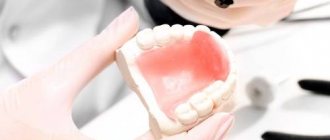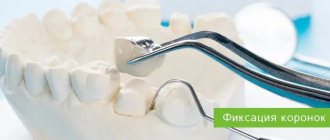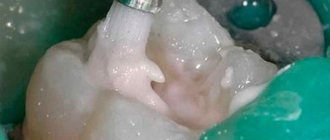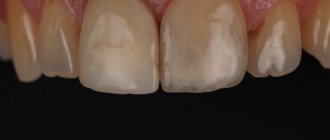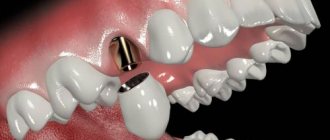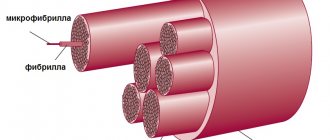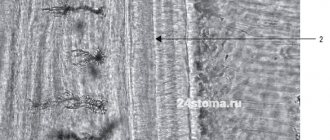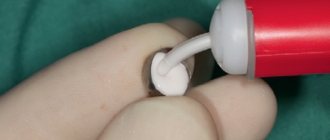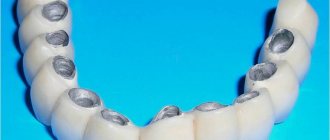Securing crowns with cement: technology features, pros and cons
The traditional method used by dentists at the start of prosthetics with implants and which has not lost its relevance to this day is as follows.
After comprehensive preparation of the oral cavity in general and the area for dental implantation in particular, the patient is implanted with an implant simulating the root of a tooth, onto which an add-on is installed - an abutment. And already on the abutment, using the same technology as on your own tooth, a crown is installed, fixed with cement.
Among the advantages of this method, it should be noted, first of all, affordability, ease of implementation and preservation of the integrity of the crown. The disadvantages of fixing a crown to an implant using dental cement are:
- entry of excess solution formed during fixation due to extrusion into the space between the gum and abutment. It is impossible to notice this process from the outside, so neither the patient nor the dentist can be sure that the cement has not entered the gum. In this case, there is a risk of inflammation of the bone tissue adjacent to the implant - peri-implantitis. Treatment of such a disease is long, complex and not always successful. A negative prognosis is the loss of the implant and part of the bone tissue, after which it will require its augmentation, and then re-implantation;
- If at least minimal inaccuracies were made when taking an impression and making the crown, its fit to the abutment will not be tight, which means that the dental cement filling this gap will be washed away by saliva over time. Its place will be taken by soft plaque containing pathogenic bacteria. As a result of decementation, the crown will simply fall out, and due to the action of bacteria, the previously mentioned peri-implantitis may begin to develop, followed by loss of the implant and bone mass.
Temporary dentures with one-stage implantation
In cases where the operation involves immediate loading (one-stage implantation is performed), the following options for temporary prosthetics are possible:
- Prosthetics on temporary abutments;
- Prosthetics with plastic or metal-plastic bridges.
The principle specified in the last paragraph is used when carrying out complex implantation practiced by the Healthy Smile clinic network. We are talking about the following:
- Complex implantation is performed when most or all teeth in the mouth are missing.
- The optimal number of implants is selected and the optimal places for their insertion are determined.
- Using CAD/CAM technologies, a PMMA prosthesis of the required length is manufactured, which will be installed on the installed implants.
The decision on the appropriateness of a particular method is made after analyzing diagnostic information and choosing the implantation method. You can undergo an examination and receive the necessary consultation at the clinics of the Healthy Smile network.
Fixing crowns using a screw method: are there any disadvantages?
The peculiarity of this method is that the abutment is not used as part of the structure, and the crown is screwed to the implant directly, using a screw. In this case, the prosthetist pre-fabricates a special crown with a hole for the screw. It would seem fast and reliable, why not? However, this fairly advanced technology is not without its drawbacks, in particular:
- aesthetic. It will not be possible to preserve the integrity of the crown covering the tooth: the shaft through which the fastening element passes will have to be closed with a composite filling. On the front teeth it will most likely be visible, so the patient will have to give up the dream of a perfect smile;
- functional. Due to the nuances of installation, the hole may occur in an area that is constantly under load, for example, on the cutting edge or masticatory tubercle. In this case, chips, cracks and gradual “eating” of the filling composite material are possible.
In addition, the manufacturing process of bridges for implant-supported prosthetics often involves minimal inaccuracies. When using dental cement in this case, correction can be carried out using a solution.
But in the process of screw fixation, with visually imperceptible inaccuracies, there is a risk of “attracting” the crowns by excessively screwing in the screw. What does this mean? At best, it will result in unpleasant sensations of tension in the patient’s oral cavity; at worst, it will result in a broken fastener, which will then have to be removed from the implant, which is a rather complicated procedure.
Immediate dentures (butterfly dentures)
Immediate dentures are removable temporary orthopedic structures, the name of which indicates “urgent” use (initially - to replace an extracted tooth).
The nickname “butterfly” is due to its appearance: the fastening elements, with their outlines, resemble the wings of a butterfly. In fact, with the help of these elements, the prosthesis is fixed in the mouth (as if it clings to neighboring teeth).
Butterfly prostheses are made from different materials, most often from nylon. Such structures are elastic, quite reliable, have high aesthetic values, and do not compress the gums (like acrylic ones). However, such prostheses are short-lived, so they are used as a temporary solution. Sometimes “butterflies” are used as an alternative to permanent dentures or solutions related to implantation in adolescents, since the dental system is not yet fully formed.
At the discretion of the doctor, a butterfly prosthesis can be installed as a way to replace missing teeth during the period of implant healing.
Conclusion: what to choose?
Based on the results of everything said above, we can conclude that there is no ideal method of fixing crowns, but the optimal one will be the one that best suits a particular patient, provided that it is chosen by a professional based on objective factors. In addition, competent and careful adherence by the orthopedist to the technology will help mitigate any shortcomings and avoid negative consequences.
The VivaDent dental clinic employs just such professional dentists - qualified, experienced and competent, which means that no matter how the crowns are installed on your implants, it will be implemented flawlessly.
Temporary cement: how does it work and when is the best time to use it?
In prosthetics, temporary cement is usually used when installing temporary and permanent crowns, as well as in cases where it is necessary to test the shade and functionality of the prosthetic structure.
Another issue is meeting deadlines: the dentist usually tells you how long to come for an appointment to remove the temporary crown and replace it with a permanent one. This means that the quality of the cement is designed to last for a certain period (temporary structures are designed to last several months). Accordingly, temporary cement has its drawbacks: displacement, loosening or complete decementation of the crown, inflammation of the gums, difficulties in cleaning the interdental spaces with dental floss.
SELECTION OF MATERIAL FOR PERMANENT FIXATION OF ORTHOPEDIC CONSTRUCTION
The final clinical stage of orthopedic treatment with fixed structures is their final fixation with cement. The reliability and effectiveness of this procedure determine the clinical durability of fixed orthopedic structures, and also affect the economic profitability of the work performed. If errors are made at the fixation stage, decementation occurs in the future, leading to various problems (seal failure, secondary caries, etc.). Elimination of these problems (re-fixation) is usually done at the expense of the clinic. Also, when the bridge prosthesis is unevenly decemented, its occlusal imbalance occurs, as a result of which chips of the ceramic may occur, requiring a complete rework of the structure.
To ensure reliable fixation, you should correctly select the fixation method, the material for fixation, and clinically competently perform all procedures and minimize possible errors.
The dental market offers a large selection of materials for fixation, varying in chemical, physical and biological properties, which often leads to difficulties in choosing the optimal material for fixing fixed orthopedic structures in various clinical situations [3]. The material must exactly match the specific clinical situation and the materials from which the fixed structure is made.
Modern materials for permanent fixation are presented in groups: zinc phosphate cement; polycarboxylate cement; glass ionomer cement (GIC); polymer-modified glass ionomer cements (modified GIC); composite materials. These materials differ in indications for use, chemical composition, reliability, protective and preventive properties, application technique and cost.
In the scientific dental literature today you can find enough publications regarding the indications for fixation for each of the above types of cements [1, 2, 3]. Zinc phosphate cements (Unitsem (VladMiVa, Russia); Unifas-2 (Medpolymer, Russia), Harvard Cement (Harvard, Germany), etc.) are recommended for fixation of single crowns (solid and metal-ceramic), small bridges (up to 3 units in the lateral region and 4 units in the anterior region) with good retention and absence of tooth sensitivity. However, the short working time of cement causes difficulties in fixing large bridge-like and fixed parts of combined prostheses. Polycarboxylate cements (Belokor (VladMiVa, Russia); Carboco (Voco, Germany); Durelon (3M ESPE, USA), etc.) are often used instead of temporary cements that do not provide sufficient retention.
Glass ionomer cements, which are biocompatible and have good adhesion to hard dental tissues and metal, are recommended for use in fixing both single crowns and bridges of 3 or more units. and fixed parts of combined prostheses. Representatives of glass ionomer cements: Fuji I (GC, Japan), Ketac Cem Easymix (3M ESPE, USA), Glassin Fix (Omega-Dent, Russia), etc.
Polymer-modified glass ionomer cements (or modified GIC) have a prolonged working time and are multi-purpose materials [1, 2]. They are used for cementing metal, metal-ceramic and metal-composite crowns and bridges based on any alloys; ceramic inlays; all-composite crowns, bridges, inlays/onlays made of composites; reinforced ceramic crowns and bridges. Representatives of RelyX Luting, RelyX Luting 2 (3M ESPE, USA); Fuji Plus, Fuji Ortho LC, Fuji CEM (GC, Japan); Vitremer Luting Cement" (3M ESPE, USA), etc.
Over the past decade, a number of scientific articles have described the disadvantages of cements of this group [2, 3]. Polymer-modified glass ionomer cements, to a greater or lesser extent, have the ability to increase water absorption after hardening, which leads to their expansion. As a result, cracks in all-metal inlays and veneers, and fractures in the roots of teeth in which anchor pins or stump inlays were fixed to this cement are possible. As well as the occurrence of post-fixation pain as a result of dentin dehydration. In addition, when working with polymer-modified glass ionomer cements, materials containing zinc oxide and eugenol cannot be used at the temporary fixation stages. The dentine bonding agent included in the kit helps to minimize the lack of these cements, which, unfortunately, is very rarely used by practicing dentists due to vague formulations from the manufacturer or the reluctance of the doctor to read the instructions.
Composite cements (self-adhesive composite cements (SCC)). Cements of this group (RelyX ARC, RelyX U200 (3M ESPE, USA); NX 3 (Kerr, Switzerland); Bifix QM, Bifix SE (Voco, Germany), etc.) do not require preliminary etching of hard dental tissues with orthophosphoric acid, and application of the adhesive system. They are used for fixing single crowns (solid, metal-ceramic, all-ceramic), small bridges, large bridges, fixed parts of combined dentures in the absence of tooth sensitivity. When working with these cements, materials containing eugenol should also not be used at the temporary fixation stages.
In everyday practice, orthopedic dentists at the Municipal Dental Clinic of the Ministry of Health of Chuvashia (Cheboksary) use all cements available on the dental market to fix all-ceramic and metal-ceramic structures.
When choosing a fixing material, clinic doctors rely on the following points [3]. Glass ionomer cements (Ketac Cem Easymix (3M ESPE, USA), Fuji I (GC, Japan) are used in traditional fixation techniques: cementing a single crown (or a small bridge - 3 units) on a vital tooth, with a core part consisting mainly of dentin, and optimal anatomical conditions (small taper, high clinical crown); cementation of the core part of the tooth, made in the form of a cast metal root tab. With this type of fixation, it is necessary to leave the dentin slightly damp - for better adhesion and minimizing postoperative sensitivity.
In clinical situations, when there is poor anatomical retention (tapered stump, low clinical crown), the tooth stump is more than 50% made of composite material, our doctors use chemically cured polymer-modified glass ionomer cements (RelyX Luting (3M ESPE, USA), Fuji CEM (GC, Japan), due to their increased adhesion and chemical affinity with the material of the tooth core.
When fixing long bridges, crowns/bridges with locking clasp dentures, crowns/bridges on implants (in situations where large occlusal loads are applied), modified GIC (RelyX Luting 2 (3M ESPE, USA)) or self-adhesive composite cements ( for example, RelyX U100 (3M ESPE, USA), having high strength, zero solubility and fracture resistance [1, 2].
Aesthetic metal-free ceramic structures (veneers, inlays, onlays and all-ceramic crowns) are fixed by doctors in the orthopedic departments of our clinic only using the adhesive method. Either dual-cure composite cements with a total etching technique are used (for example, Relyx ARC (3M ESPE, USA)), or self-adhesive composite cements (for example, RelyX U100 (3M ESPE, USA). When adhesive fixation, it is necessary to strictly follow the instructions of the specific bonding system, ensure isolation of the working field (rubber dam, retraction sutures), apply a sufficient amount of composite cement to completely seal the edges of the restoration.
When choosing dental materials, each dentist must be guided by clear criteria to improve the quality of dental care, work with high-quality and proven reliable materials. The permanent fixation material must be optimally compatible with the components of orthopedic structures - metal, ceramics or composite, have clear advantages in long-term follow-up and, undoubtedly, optimally balanced price-quality indicators.
Bibliography
1. Analysis of the clinical effectiveness of cements for permanent fixation of dentures. / O. G. Polyanskaya, T. N. Klimova, V. I. Shemonaev, V. A. Vinshu, V. A. Stepanov // Volgograd scientific and practical journal. – – No. 4. – 2015. – P. 41 – 44.
2. Nikolaev Yu.M. New generation of fixing cements in the clinic of orthopedic dentistry // Problems of dentistry. - No. 3. – 2012. – P. 50 – 53.
3. Rosenstiel S.F., Land M.F., Fujimoto Y. Orthopedic treatment with fixed prostheses. // S.F. Rosenstiel, M.F. Land, Y. Fujimoto. lane from English, under general ed. prof. Lebedenko. – M.: MEDpress-Inform, 2008. – P. 348 – 376.
Installation of a temporary crown
The placement of a temporary crown is usually completed in one visit to the dental office. The installation process takes about 10-30 minutes. The procedure is painless. Grinding and correction of teeth are performed under local anesthesia.
First, the dentist prepares the tooth for a permanent crown. The tooth surface is ground down approximately 1-2 mm on each side.
Impressions of the teeth are then created. They are sent to a dental prosthetics laboratory, where permanent crowns are created.
While they are being made, the patient is given a temporary plastic crown. Once the dentist has received the finished permanent crown, he places it on the patient's tooth.
During the first days after the procedure, the patient may feel discomfort because the shape of the tooth with a temporary crown may be slightly different from what it was before.
Possible complications and side effects after the procedure:
- Discomfort
- Tooth sensitivity
- Allergic reaction
General characteristics of the material
Dental cement
It contains powder and liquid, when mixed, a paste-like mass is formed.
Dental glass is used to mix dental cement .
An accompanying attribute is dental glass for mixing cement, available without a hole, with 1, 2, 3 holes
During the hardening process, the mass begins to harden and becomes like stone. Hardening occurs as a result of the components entering into a chemical reaction.
The main indicators that high-quality dental cement
, the following:
- mixing time;
- work time;
- curing time.
Mixing time refers to the period of time recommended for preparing the solution. Typically this figure is 90 seconds , and it is not recommended to exceed it.
The time during which the doctor must have time to apply the mixture to the tooth and model the filling is called working time. Each manufacturer of dental cement has its own characteristics, but the average varies from 4 to 10 minutes .
The period allotted for hardening of the cement mass also varies among manufacturers. Sometimes it can take a week for the ingredients to react and cause hardening. An important role in the setting of the material is played by the temperature and mixing proportions of dental cement.
with liquid.
